

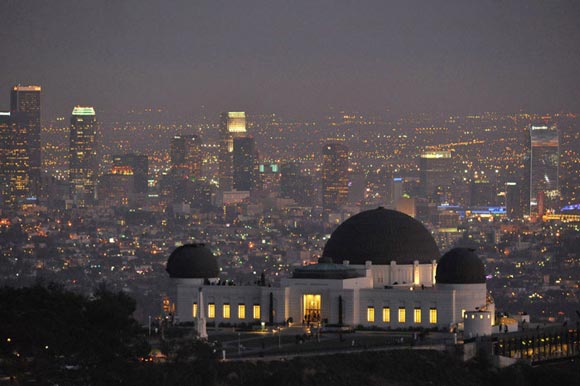
Griffith Park Observatory, Los Angeles, California
I didn’t have to travel far for this shot, but a shooting strategy was still in place. I wanted to capture the image during the "magic hour" of the evening, just after the sun sets when the light is soft and beautiful. Practice balancing low light night conditions along with existing city lights for dramatic results. A stop of F–11 for 2–5 seconds will capture light streaks from cars to add character and style.
“No place is boring, if you’ve had a good night’s sleep and a pocket full of unexposed film.” – Robert Adama
I’ve taken you to Asian countries during my Photo Wanderlust travels, but this article will get you prepared for any city near or far. As American Army General Eisenhower once said, "Plans are useless, but planning is indispensable." That saying goes hand in hand for photographers as well, so first, plan what camera equipment will best meet your needs and best suit your style of shooting. Then, if you’re going to an unfamiliar place, be sure to acquire information about the area. It’s all a process of discovery. If you have a basic strategy set in place, your experiences will be much more rewarding.

Mexico: Failure to plan ahead will limit options and you may find yourself painted into a corner.
Since I’m used to carrying a lot of equipment, I take a lot of equipment with me in order to meet my various styles of shooting. If you have an extra camera, I suggest taking it with you just in case something happens to your primary camera. Even a point and shoot means you won’t miss the shot.
Cameras As I travel, I rig my tool chest to best suit my various photographic styles.
1. Primary camera: Nikon D700—a rugged full sensor 35mm camera .
2. 1960 Leica M–2 that features Leitz glass for black and white photos. The rangefinder focus system makes it easy to quickly rack focus.
3. Widelux Panoramic camera. It’s a small 35mm camera, which exposes 1–1/2 frames per shot making it perfect for wide vista shots. The lens housing mechanically swings left to right to fill the frame without perspective distortion.
A 9mm fisheye lens, a 20mm–F2, a 50mm–F1.2, a 105mm–F1.8, and a 300mm–EDIF–F2.8 completes the lens package. I compliment my 300mm with a Nikon doubler which gives me an instant 600mm focal length at a two–stop loss.
The auto focus lenses are great, but too sharp for my liking. I prefer the softer looking image created by the old school primes. I would audition multiple lenses of various focal lengths to find the lenses that gave me the feel I liked. Some were too green or the focus would fall off at the edges too quickly. Each lens has its own look, so I wanted lenses that suited my taste.
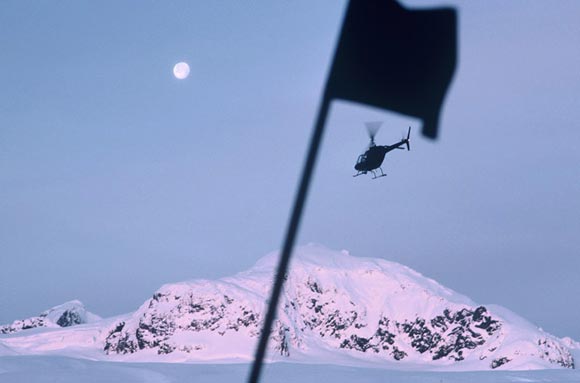
Alaska: Stage your foreground and background, then wait for that perfect moment to snap the shot.
Having your gear handy with a full compliment of focal lengths provides the ammo needed so you can concentrate on having fun and making interesting photographs.
Changing Lenses Tip: Don’t forget to always turn the camera off during any lens change. An energized camera sensor creates static electricity and that attracts dust and dirt artifacts that will ruin all your images. And remember, traffic on roads and people milling about creates even more dust, so back away.
Time exposures require stability and there are a variety of ways to keep your camera steady. I carry a small 8" tripod for shooting from flat surfaces. I also carry a small c–clamp with a 5/16" pin so I can quickly attach my camera body safely to objects where the tripod won’t work, such as a park bench. And for uneven surfaces, I just grab my backpack. I also carry a space blanket for protection from foul weather or to use as a ground cover.
“It is not down in any map; true places never are.” – Herman Melville
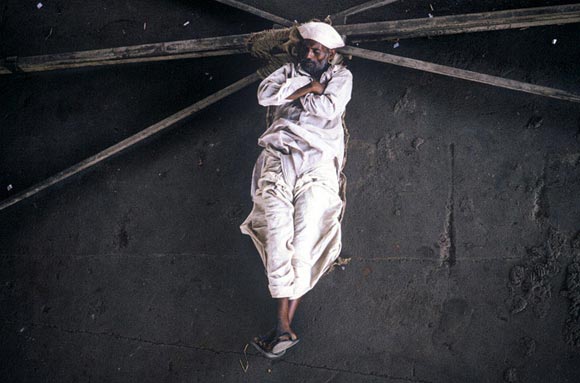
Rail Station, New Delhi, India Look up, look down and look all around—concentrate on finding fun subjects.
Every photographer has his or her favorite locations where they feel comfortable and confident of finding good photos. I always find interesting photo material within the city streets, along railroad tracks, at local parks, on top of and under bridges, at festivals and markets, and along a riverfront. And another fun location is at a zoo, where the combination of children and animals makes for a fun afternoon of "shooting." But no matter where you are, if you really look, there will always be something to photograph.
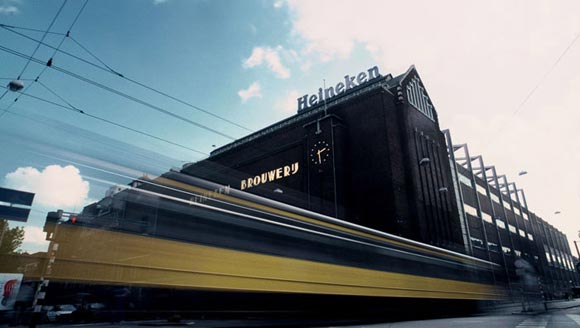
Heineken Brewery, Amsterdam: Some of my favorite locations are areas with railroad tracks. To add interest to the brewery and motion to the shot, I waited for the train and shot it using a time exposure.
I usually try to catch the sunrise with its low scraping or dramatic sidelight or the "magic hour" just after sunset which provides beautiful soft images.
By 10 o’clock in the morning the sun is high in the sky and not in general favor of photography, so if I’m traveling away from home, I’ll spend the middle of the day either relaxing or going in search of new locations to prepare for my next photo adventure.
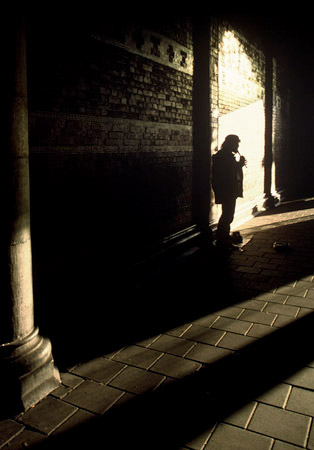
Below the Riksmuseum, Amsterdam, Holland: It’s hard to beat the use of natural light. Awareness of light and shadows plus a bit of imagination pulls the elements of this photo together.
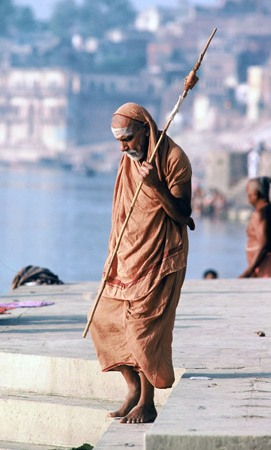
Learning the sun’s direction and timetable is helpful in forecasting the next shot. Then I lay in wait to let the subjects do the work. This Holy man was making his rounds by the Ganges River, Varanasi, India
Strategy for the Candid Shot The candid shot requires the photographer to be as inconspicuous as possible. It’s not an eye–to–eye contact photo you’re trying to capture, so there is no personal connection with the subjects. I hide around corners and natural objects that I can use as blinds. This gives me protection from curious eyes. I don’t want others giving away my position too soon. I love to get my 300 mm and find the perfect location to stage my shot. I pay attention to the sun and look for beautiful lighting and backgrounds. Where will the reflections reveal themselves? Where will the shadows fall? How will the light strike my subject?
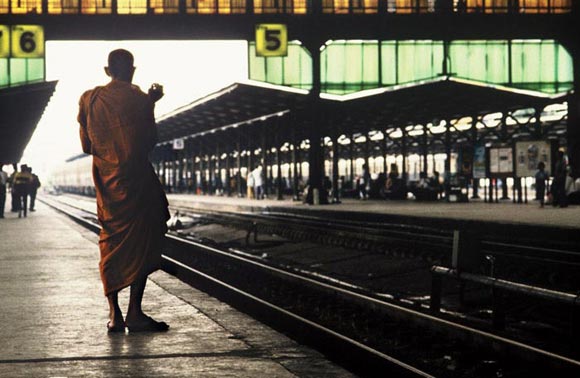
Bangkok, Thailand: The first piece of business is to position myself so I have a pleasing background.
The background will make or break a photo.
When shooting, I try to stay low, slowly come out to get a frame or two, and then disappear for a time to let the cityscape restage itself with fresh material. Depending on my subject, I may shoot low and wide. Or, I’ll start by shooting with a long lens and then as I slowly move my position closer, I’ll change over to a 105mm portrait lens. That’s when the session may change to a more intimate setting. I truly enjoy the discovery.
Street Strategy Tips for any street, any city, & any country: It’s easy to get tunnel vision while on a photo hunt. Don’t lose sight of the dangers and potential accidents along the way. Always keep your eyes and brain on alert. By staying too long in one spot not only burns your position for the candid shot, but it also gives a thief time to study you. They will watch your every move and wait until the time is right. The hunter can quickly become the hunted. Because of your gear or your appearance you stand out from the crowd. I never want to over stay my welcome.
My previous articles about security and "hunting people" cover this topic in more detail.
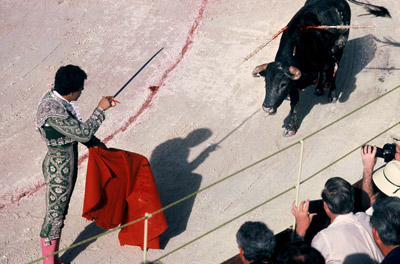
Mexico: I call this photo "Cowards". Sometimes luck plays a big part in capturing those special moments. Here I happened to capture the moment when the shadow from the sword fell on the tip of the bull’s nose.
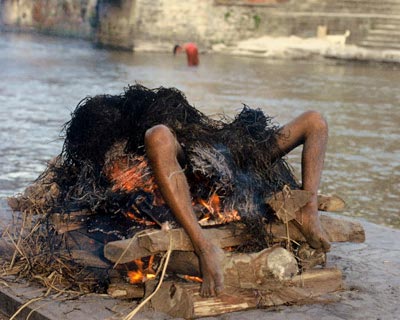
Kathmandu, Nepal
I discovered this holy cremation site on my walk about—certainly not something one would see in the U.S. I then noticed the woman in the background washing her clothes in the river. I made my way to the other side of the river so I could capture the contrast in subjects. Looking beyond the obvious is a key to finding interesting material.
Finding visually unique angles from above is a rewarding challenge. I often look for tall buildings and approach the security staff for permission to access the roof. If I’m lucky enough to find that perfect location, I can stay for some time and not disturb anyone. Many times I show my appreciation to the guard by some small monetary reward or snack. It’s always appreciated. Cities are changing fast so new locations are always there for the taking, so don’t be afraid to ask.
I asked, but...be prepared for the unexpected!
Calcutta’s massive Howrah Railway Station is a shooters dream location. It offers a unique grand vista of a magnificent city. The imposing bridge of the same name spans the Hoogley River where over one million people cross each and every day. My traveling friend and I asked a guard for roof access and off we went. We followed him up a maze of stairs and passages to the rooftop. We managed to get to the edge of the building and took in the visual feast while setting up our shots. What a unique vantage point. This entire microcosm of Indian life is on display right below me.
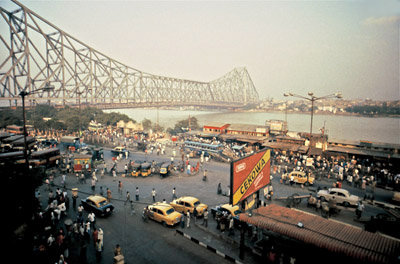
Calcutta, India: A quick shot from the rooftop of Howrah Rail Station.
We stood there on the roof taking it all in when a loud voice commanded us to come to them. We had the distinct feeling that this was the end of our field trip, so I very quickly snapped off a few shots.
We walked over to the official and I politely told him we were given permission to gain roof access. It appears that the fellow who led us up to the roof was now nowhere to be found. The officer held his hands out then sternly commanded, "Deposit your cameras here!" I politely refused. Again he commanded us to hand over our gear. While he was extending his arms for our cameras, I tried to explain that we were just tourists, while always smiling and while at the same time retreating. Not wanting any further official intervention, we committed ourselves to leave the scene in a big hurry. I don’t quite know or remember how we found our way back down to the street level, but wedded and hastily made it the short distance to the riverbank where we quickly jumped into an outgoing riverboat taxi and made our escape across the river. I didn’t care where we were going. Only that we were free with our cameras intact. Whew... There is a saying that "timing makes champions". We were very lucky to have it end there. Good memories and a few fun shots.
“He who has seen one cathedral ten times has seen something; he who has seen ten cathedrals once has seen but little; and he who has spent half an hour in each of a hundred cathedrals has seen nothing at all.” – Sinclair Lewis on sightseeing
Set a pace that gives you options and lets you have the freedom to expand without putting hard constraints on yourself. Take the time to enjoy your time.
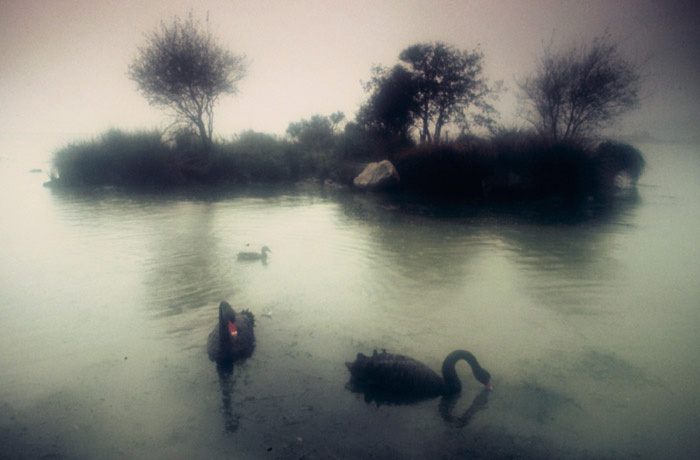
Lake Rotorua, New Zealand
Take some time to slow your pace and just sit and watch. On a foggy, colorless morning I found these swans swimming in the lake. To add diffusion and a soft effect, I blew hot air onto the lens and then waited a moment for the condensation to clear from the center before capturing the photo.
Moving from place to place through a location requires a bit of organization and a general shooting strategy. Only then will you have a complete and organized tool chest for maximum creative freedom resulting in great photos. For me it satisfies my addiction to photography, plus it’s so much fun.